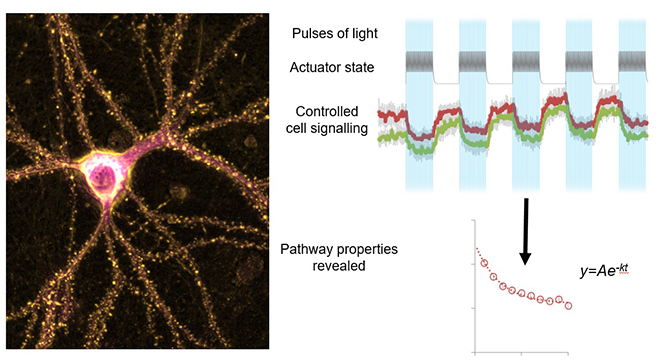Oct 23 2020
Aberrant cell signaling processes lead to many diseases and hence, fundamental research in cell signaling is required to determine targets for upcoming therapeutic methods, particularly in cases where no effective treatments or cures are available at present.
 The expression of optogenetic actuators in neurons allows precise non-invasive control of signaling pathways using light pulses. This permits a better understanding of the pathway modified in neurological disorders. Adapted from https://doi.org/10.1038/s41467-020-18816-8 under CC-BY-4.0. Image Credit: Michael Courtney.
The expression of optogenetic actuators in neurons allows precise non-invasive control of signaling pathways using light pulses. This permits a better understanding of the pathway modified in neurological disorders. Adapted from https://doi.org/10.1038/s41467-020-18816-8 under CC-BY-4.0. Image Credit: Michael Courtney.
Cellular optogenetics utilizes light to accurately regulate cell signaling in space and over time, rendering it an extremely useful method for disease research.
But a majority of the researchers have found it difficult to use this potentially revolutionary technique because, over extended periods of time, the used light can itself have detrimental effects on biological systems, and the optogenetic tools can deactivate abruptly and quickly.
Scientists from the University of Turku in Finland, in association with Frankfurt University Hospital in Germany, have now designed an innovative method to harness the quantum mechanical phenomenon of resonance energy transfer to develop optogenetic tools that are highly sensitive to light.
In addition, the latest technique clearly informs users when an optogenetic tool is going to deactivate in cells. If continued activity is needed, just the correct amount of extra light can be subsequently re-applied to activate the tool again.
Integrating such advances with prevailing tools and knowledge, the team was able to develop and construct more efficient optogenetic tools to analyze signaling pathways.
With the help of enhanced tools, the researchers examined two common chemotherapy medications that are known to have adverse effects on neurons and lead to neuropathic pain. The novel tools demonstrated how inhibitory as well as activatory pathways contribute to the actions of these medications on the studied disease-associated pathway.
Now we can develop more powerful tools to understand precisely how harmful conditions disrupt signaling in living cells. This information is likely to help us in identifying targets and designing better therapeutic compounds for conditions such as chemotherapy-induced neuropathic pain.
Lili Li, Study Lead Author and Postdoctoral Researcher, Turku Bioscience Centre, University of Turku
“There is still considerable potential to further exploit these quantum mechanical phenomena to devise even better quantitative and informative methods in biology and medicine, which could support the future discovery of new therapeutic approaches,” concluded Michael Courtney, the senior author of the study.
The study was financially supported by the Magnus Ehrnrooths Foundation, the National Institutes of Health’s National Cancer Institute, the European Union Erasmus + program and 7th Framework Program Initial Training Networks, the Academy of Finland, and DAAD mobility programs.
The research work was also supported by facilities of the Turku Screening Unit, a member of the Biocentre Finland Drug Discovery and Chemical Biology Network.
The study was published in the Nature Communications journal.
Journal Reference:
Li, L., et al. (2020) Resonance energy transfer sensitises and monitors in situ switching of LOV2-based optogenetic actuators. Nature Communications. doi.org/10.1038/s41467-020-18816-8.